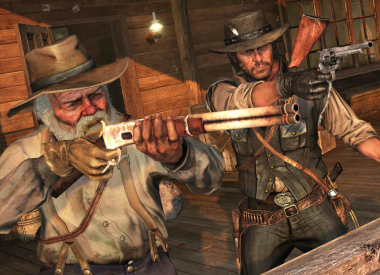If you’d told me a few years ago that the Dragon Quest franchise would be responsible for two of my favorite spinoffs in recent memory, I’m not sure how I’d have responded. The series never found much of an audience in North America and I seem to be far more in love with the idea of sandbox gaming, the latest genre getting some DQ love, than actually spending dozens of hours with titles like Starbound. But I have been pleasantly surprised by the latest side-story in the Dragon Quest franchise. And I suspect I’m not the only time-strapped gamer who will find plenty to love in Dragon Quest Builders.
Dragon Quest Builders follows the adventures of the legendary Builder, a hero prophesied to save mankind in its darkest hour. Your task: Rebuild the cities and villages of Alefgard, hundreds of years after they were destroyed by the Dragonlord. In this alternate timeline, the antagonist from the original Dragon Quest successfully convinced the game’s hero to abandon his quest — to defeat said evil overlord — only to betray the protagonist moments later. With all opposition removed, the Dragonlord’s monsters were turned loose on the rest of humanity. The rest, as they say, is history. But it doesn’t have to stay that way.
The game’s story is divided into four chapters, each focused on a different city destroyed by the Dragonlord and his monstrous armies. But reconstruction isn’t as simple as showing up in the town square and placing a few blocks. Players must complete quests for their neighbors, building specific structures and/or retrieving needed resources, while fending off invasions from increasingly dangerous monsters. Along the way, you’ll meet new allies, learn how to build (or uprgrade) dozens of rooms and learn more about the post-DQ history of Alefgard. It’s everything you’d expect from a sandbox game, presented in a shockingly efficient (and linear) fashion.
At it’s core, Dragon Quest Builders is a sandbox RPG. Combat plays a bigger role in DQB than some fans may expect, given how frequently it’s minimized by the genre, but that information comes as less of a shock if you’re familiar with the game’s roots. Turn-based combat was a major component of the Dragon Quest franchise and many of the enemies fans remember from the original series return in Dragon Quest Builders. But construction remains the central focus in DQB . It’s even how the player progresses through each chapter, gaining experience by building and decorating new rooms, and, you know, completing the rebuilding process.
What may turn some off from the game is the fact Dragon Quest Builders resets large portions of your individual progress when transitioning between chapters. The number of item recipes you keep during the move changes, increasing as you progress through the game, but you definitely feel like you’re starting at (or near) square one in each new city or village. All of the items you’d collected over the last few hours disappear, along with the equipment you’ve forged, and sometimes materials you relied on in one chapter aren’t even available in the next.
As each town grows, the player will gain access to a series of portals, each leading to nearby islands that are otherwise inaccessible. Each new location provides access to new materials, along with new enemies and a handful of new quests for the local residents. Small invasions are also triggered by the player every few hours, upon completing the latest batch of quests and increasing the the level of the city currently under construction. These events aren’t especially difficult or patience-trying, with the exception of the boss battles at the end of each chapter, but they do begin to lose their luster long before the credits roll.
Without question, combat is the weak link in the Dragon Quest Builders chain, replacing the series’ vaunted, turned-based action with a single, spammable attack button that leaves DQB feeling similar to old hack-and-slash games. Many enemies can be cheesed, particularly during town invasions, when villagers will frequently pull aggro, and even the game’s optional boss encounters aren’t particularly tough. Every fight pretty much boils down to circle-strafing your target and spamming the attack button. To be fair, combat clearly isn’t the game’s focus, nor is it the primary reason most of us are engaging with the game. But it is a mandatory part of the Dragon Quest Builders experience and probably could’ve used a bit more polish. Something as simple as a block button, or light and heavy attacks, would’ve gone a long way. There’s a spin attack, that can be helpful if you get surrounded, but it doesn’t exactly add much depth.
Once players have finished with Dragon Quest Builders’ narrative bits, or decide they’d rather build aimlessly, Terra Incognita provides a structureless (and threat-free) map to use as your own personal canvas. Like the rest of the DQB experience, Square Enix’s version of Creative Mode is significantly smaller — with a maximum build height of just 30 blocks — than the games that inspired Dragon Quest Builders, We’re also disappointed by the dev team’s decision to limit recipe access in the game’s “free build” mode, since there will certainly be players uninterested in completing the DQB campaign, but it should be more than enough to keep the Dragon Quest Builders community engaged for days (maybe weeks or months) after they’ve finished the story.
Dragon Quest Builders won’t appeal to everyone. Games like Minecraft and Terraria have taken hold, particularly among younger gamers, because they offer a seemingly endless number of outlets for one’s creative energy. Meanwhile, DQB is a decidedly more measured approach to the sandbox genre, prioritizing an internal sense of purpose and progress, along with easily-recognizable landmarks, over the endless expanses and random wonders of a procedurally-generated world. But we don’t all have time to explore infinitely. In fact, many older gamers, who no longer have as much time to dedicate to video games, will undoubtedly welcome some of the boundaries and limitations introduced by Square Enix.
If the latter description sounds like you, then it would be near impossible to recommend Dragon Quest Builders too strongly. It is sandbox gaming on rails, giving players just enough freedom to deserve its genre placement without exposing them to an overwhelming array of resources and recipes. Gating some content behind the game’s narrative progression may irritate those with substantial genre experience. But the system provides a streamlined sandbox experience for those of us with less time; a design philosophy that clearly sets Dragon Quest Builders apart from the competition.
Full Disclosure: The PS4 copy of Dragon Quest Builders used in the creation of this review was provided by a representative of Square Enix; however, the publisher did not retain any editorial oversight/privileges.
Dragon Quest Builders is now available on PlayStation 4 and PS Vita.
Be sure to check back with iDigitalTimes.com and follow Scott on Twitter for more Dragon Quest Builders coverage throughout 2016 and however long Square Enix supports Dragon Quest Builders in the months following launch.


















